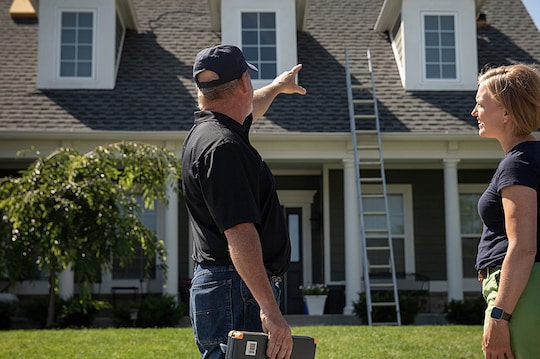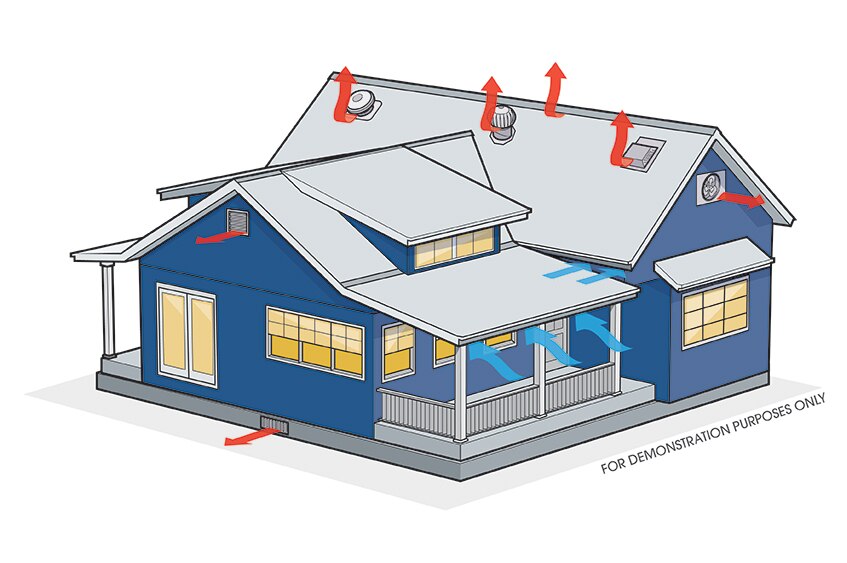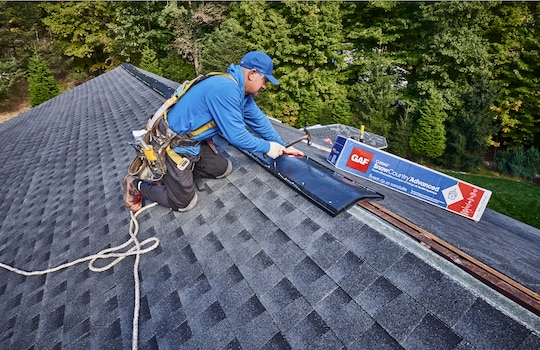
Toitures résidentielles
Comment les innovations en matière de bardeaux d’ouragan protègent votre toit des tempêtes
Chaque année, les ouragans provoquent des milliards de dollars en pertes pour les propriétaires de maison dans tout le pays. Dans un effort de remédier à cela, l’industrie de la toiture a fait des progrès pour aider à réduire l’impact des dégâts causés par les tempêtes, y compris des bardeaux conçus spécialement qui peuvent résister aux forts impacts et aux vents puissants. Si vous vivez dans une région propice aux ouragans, voici ce que vous devez savoir sur les bardeaux pour ouragans conçus pour résister aux vitesses de vent élevées et aux impacts de débris qui peuvent être associés aux grands ouragans. Comprendre les bardeaux résistants aux chocs Les bardeaux pour ouragans, (ou bardeaux résistants aux chocs) sont conçus pour résister aux chocs et aux vitesses de vent élevées. Ils sont robustes, souvent fabriqués à partir d’une combinaison unique de styrène-butadiène-styrène (SBS) et d’asphalte, offrant plus de solidité que les bardeaux en asphalte non renforcés. Dans les zones propices aux ouragans, les vents intenses peuvent facilement souffler des débris et autres gros objets comme des branches d’arbres sur un toit. Les bardeaux qui ont réussi l'essai de résistance aux chocs certifié UL 2218 de classe 4 sont plus efficaces pour limiter les dégâts dus aux impacts. Ces bardeaux sont testés en laissant tomber une balle en acier de 2 pouces d’une hauteur de 20 pieds. Cette balle en acier impacte de nombreux endroits cibles des bardeaux sur le platelage d’essai. Ce test inclut deux impacts par endroit cible. Les bardeaux doivent résister à l’impact sans montrer aucun signe de ruptures ou de fissures. Ces bardeaux doivent aussi être capables de résister aux vitesses de vent des ouragans de catégorie 3, allant de 111 à 129 mi/h. Choisir les bons bardeaux pour votre toit Lorsque vous choisissez des bardeaux pour ouragan, vous devez prendre en compte leur classification des vents, leur résistance aux chocs et les garanties. Classification des vents Qualité, les bardeaux certifiés UL 2218 de classe 4 de résistance aux chocs doivent être capables de résister au moins à des vents de 110 mi/h. Ces bardeaux sont souvent fabriqués en métal ou en asphalte mélangé avec du SBS. Par exemple, le système de toiture TimberSteelMC de qualité supérieure de GAF est efficace contre les vitesses de vent élevées en raison des couches de protection conçues de manière innovante pour aider à protéger votre maison des éléments. Résistance aux chocs Les matériaux de toiture pour ouragan de bonne qualité, y compris les bardeaux résistants aux chocs, disposent d'une protection renforcée contre les impacts d’objets, en particulier de la grêle. Bien que ces bardeaux peuvent être plus chers que les bardeaux en asphalte non renforcés, ils requièrent généralement moins d’entretien. Et comme ces bardeaux peuvent résister à certains types d’impacts qui ont souvent lieu pendant un ouragan, il se pourrait que moins de réparations soient nécessaires. Garanties Prenez en considération les garanties des bardeaux et ce qu’elles couvrent. Une garantie contre le vent peut garantir la réparation et le remplacement de votre toit pour certaines vitesses de vent spécifiques si votre toit satisfait toutes les exigences de la garantie. Innovation de GAF en matière de toits pour les ouragans Certains des bardeaux GAF comme le TimberlineMD AS II ont les meilleurs classements possibles pour la résistance au vent et aux chocs. Ils correspondent au meilleur classement possible, la classe F pour la méthode d'essai standard pour la résistance au vent des produits de toit à forte pente (ASTM D3161). Cela signifie qu'ils peuvent résister à des vents de jusqu'à 110 mi/h. Les bardeaux TimberlineMD AS II ont également le meilleur classement, Classe H, pour la classification de la méthode d'essai standard pour la résistance au vent des bardeaux en asphalte (ASTM D7158). Cela signifie que les bardeaux peuvent résister au soulèvement par le vent à des vitesses allant jusqu’à 150 mi/h. Si cela n'était pas suffisant, la classe 4 de la classification pour l’essai UL 2218 de ces bardeaux signifie qu’ils peuvent résister au test de la chute d’une balle d’acier de 2 pouces d’une hauteur de 20 pieds. Obtenant les classifications les plus élevées pour tous ces tests, les bardeaux TimberlineMD AS II sont éprouvés et testés dans des conditions les plus proches possibles d'un ouragan (l’essai est effectué dans dans des conditions d’essai en laboratoire contrôlées). Le matériel en asphalte SBS modifié robuste et la technologie LayerLockMD aident à renforcer votre toit contre le vent, la pluie et la grêle. Ces bardeaux GAF sont également admissibles à la garantie limitée contre le vent WindProvenMC**, qui offre une protection sans limites contre les vents lorsqu’ils sont installés avec la combinaison requise de quatre accessoires GAF. Conseils pour l'installation de bardeaux et l’entretien de toit L’installation adéquate des bardeaux résistants aux chocs est essentielle pour qu’ils offrent la meilleure performance, alors choisissez un couvreur expérimenté. Ils sauront comment clouer correctement les bardeaux et s’assurer qu’ils sont solidement attachés entre eux et au toit afin d’éviter toute ouverture pour des fuites ou faiblesses. De plus, demandez à votre couvreur s’il sait comment installer des attaches pour ouragan pour aider à éviter que votre toit ne s’envole pendant une tempête. Une fois que votre toit est installé, effectuez un entretien régulier annuel avant et après la saison des ouragans. Remplacez tout bardeau manquant ou cassé, et fixez tout bardeau mal fixé. Remplacez également tous les clous ou solins qui sont rouillés. Lors de l’entretien de votre toit, assurez-vous que vos gouttières fonctionnent bien et enlevez toutes les feuilles permettant ainsi que l’eau s’écoule loin de votre maison. Un point de faiblesse dans un toit peut empirer encore plus dans des conditions climatiques d’ouragan intenses et s’assurer que votre toit se trouve dans des conditions stables peut aider à vous garder et votre toit en sécurité. FAQ Quels sont les meilleurs bardeaux pour les vents intenses? Les meilleurs bardeaux pour les vents intenses sont ceux de la Classe F pour le test ASTM D3161 et la Classe H pour le test ASTM D7158. Ces deux classifications indiquent que les bardeaux ont les meilleures classifications pour résister aux vents d’ouragans. Est-ce que le bardeaux résistants aux chocs durent plus longtemps? En raison de leur construction durable fabriquée en asphalte modifié SBS qui rend les bardeaux plus flexibles et capables de mieux résister aux effets des impacts que les bardeaux de style architectural standard, les bardeaux résistants aux chocs de GAF sont conçus pour durer de nombreuses années. Se préparer pour la prochaine tempête Examinez votre toit à la recherche de dégâts après la saison des ouragans. Lisez ce guide de GAF sur les dégâts de toit causés par les tempêtes pour apprendre ce que vous devez rechercher et à quoi vous attendre en matière de réparations. Si votre toit a besoin de travaux avant ou après une tempête, contactez un entrepreneur certifié* dans votre région pour de l’aide et du soutien. *Les entrepreneurs inscrits dans les programmes de certification de GAF ne sont ni des employés ni des agents de GAF, et GAF ne contrôle ni ne supervise ces entreprises indépendantes. Les entrepreneurs peuvent recevoir des avantages, tels que des points de fidélité et des remises sur les outils de marketing de GAF pour avoir participé au programme et offert des garanties améliorées GAF, qui exigent l'utilisation d'une quantité minimale de produits de la marque. Vos relations avec un entrepreneur et tous les services qu’ils vous fournissent sont soumis aux conditions d’utilisation de l’entrepreneur GAF. **La garantie limitée contre le vent de 15 ans WindProvenMC couvre les bardeaux GAF avec la technologie LayerLockMD seulement, et exige l’utilisation des bandes de départ GAF, les sous-couches à haute performance, les bardeaux de faîtière et la membrane d’étanchéité ou la ventilation de grenier. Voir la Garantie limitée pour système de toiture afin de connaître l'étendue de la protection et les restrictions. Visitez gaf.com/LRS pour connaître les produits GAF admissibles. Pour les installations non couvertes par la garantie limitée contre le vent WindProven, consultez Garantie limitée sur les bardeaux et les accessoires GAF pour en savoir plus sur la couverture complète et les restrictions.
Par les auteurs Mark Soto
06 décembre 2024



